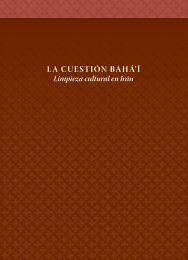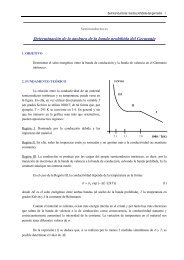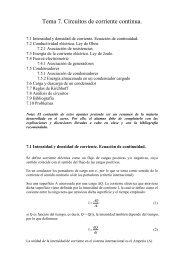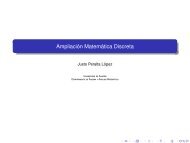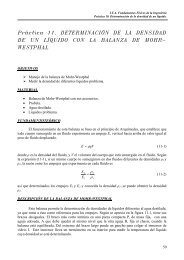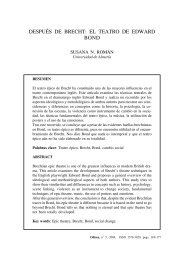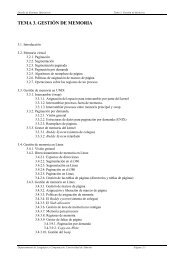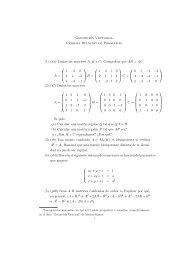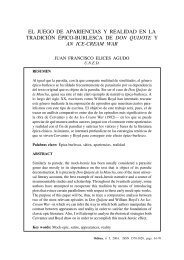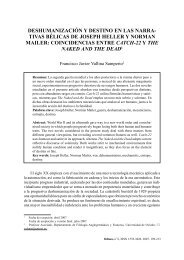teaching language through literature - Universidad de AlmerÃa
teaching language through literature - Universidad de AlmerÃa
teaching language through literature - Universidad de AlmerÃa
You also want an ePaper? Increase the reach of your titles
YUMPU automatically turns print PDFs into web optimized ePapers that Google loves.
Pilar Agustín Llach<br />
Teaching Language <strong>through</strong> Literature:...<br />
7<br />
TEACHING LANGUAGE THROUGH LITERATURE:<br />
THE WASTE LAND IN THE ESL CLASSROOM 1<br />
Pilar Agustín Llach 2<br />
Abstract: This article intends to show how <strong>literature</strong> may be used in <strong>language</strong> classes<br />
to <strong>de</strong>velop stu<strong>de</strong>nt’s knowledge of English. First, we examine the evolution of <strong>literature</strong><br />
in the <strong>language</strong> classroom, then we give account of some reasons that justify its use in<br />
<strong>language</strong> classes, of the role of reading in <strong>language</strong> <strong>de</strong>velopment, and of the way poetry<br />
is treated in the ESL classroom. The Waste Land is a good work to be used as a tool to<br />
<strong>de</strong>velop stu<strong>de</strong>nt’s communicative competence in English. The article ends with a didactic<br />
proposal for ESL instruction based on the poem.<br />
Key words: Literature and <strong>language</strong> <strong>teaching</strong>, ESL, The Waste Land, reading.<br />
Resumen: Este artículo preten<strong>de</strong> <strong>de</strong>mostrar cómo la literatura pue<strong>de</strong> contribuir a <strong>de</strong>sarrollar<br />
el conocimiento <strong>de</strong> los alumnos en la lengua extranjera inglés. Primero examinamos la<br />
evolución <strong>de</strong> la literatura en la clase <strong>de</strong> lengua y damos cuenta <strong>de</strong> las razones que justifican<br />
su uso, <strong>de</strong>l papel <strong>de</strong> la lectura en la adquisición <strong>de</strong> la LE, y <strong>de</strong>l tratamiento <strong>de</strong> la poesía<br />
en clase <strong>de</strong> LE. The Waste Land es una obra a<strong>de</strong>cuada para ser usada como instrumento<br />
para <strong>de</strong>sarrollar la competencia comunicativa <strong>de</strong>l aprendiz en inglés. El artículo termina<br />
en una propuesta didáctica para la instrucción <strong>de</strong>l inglés basada en el poema.<br />
Palabras clave: La literatura en la enseñanza, inglés lengua extranjera (LE), The Waste<br />
Land, lectura.<br />
1. INTRODUCTION<br />
This paper aims to pinpoint the relevant role of <strong>literature</strong> as a resource for second<br />
<strong>language</strong> <strong>teaching</strong>. Here the focus will be on the use that <strong>language</strong> teachers may make<br />
of the mo<strong>de</strong>rnist text The Waste Land in or<strong>de</strong>r to help stu<strong>de</strong>nts <strong>de</strong>velop their proficiency<br />
in English. Literature supplies many linguistic opportunities to the <strong>language</strong> learner and<br />
allows the teacher to <strong>de</strong>sign activities that are “based on material capable of stimulating<br />
greater interest and involvement” than many other non-literary, informative texts (Carter<br />
and Long 1991: 3). The aim of these activities should be to focus on the form and content<br />
of the text at stake, and to provi<strong>de</strong> the stimulus for interaction to take place between the<br />
learners among them, and with the teacher (Duff and Maley 1990: 3).<br />
This paper is framed within the communicative approach to <strong>language</strong> <strong>teaching</strong>. This<br />
implies that the <strong>de</strong>velopment of communicative competence should be the last aim of any<br />
<strong>language</strong> activity. The relevance of <strong>literature</strong> in this approach is, on the one hand, that it<br />
1<br />
Date of reception: March 2007.<br />
Date of acceptance and final version: April 2007.<br />
2<br />
Assistant Lecturer, Departamento <strong>de</strong> Filologías Mo<strong>de</strong>rnas, <strong>Universidad</strong> <strong>de</strong> la Rioja; maria-<strong>de</strong>l-pilar.<br />
agustin@unirioja.es.<br />
Odisea, n º 8, ISSN 1578-3820, 2007, 7-17
8 Pilar Agustín Llach<br />
Teaching Language <strong>through</strong> Literature:...<br />
transmits messages. It is a way of communication between the author and the rea<strong>de</strong>r. On<br />
the other hand, <strong>literature</strong> pays special attention to form, and this helps the learner reflect<br />
about <strong>language</strong>, another principle and goal of the communicative method. It is important<br />
that the learners <strong>de</strong>velop their linguistic competence by learning how to express meanings<br />
in English, but also that they <strong>de</strong>velop their communicative competence, that will allow them<br />
to transmit messages, to use the <strong>language</strong> to interact, to communicate with other people,<br />
which is, in the end, the basic function of <strong>language</strong>. The use of <strong>literature</strong> as a <strong>teaching</strong> tool<br />
is legitimated by the facts mentioned above, namely, because it provi<strong>de</strong>s with authentic<br />
linguistic (also sociolinguistic) and cultural material, and because it motivates the learners<br />
to interact.<br />
The literary text chosen belongs to the mo<strong>de</strong>rnist tradition and has never been used<br />
in the <strong>literature</strong> as a <strong>language</strong> <strong>teaching</strong> resource. The poem The Waste Land is very much<br />
a<strong>de</strong>quate for <strong>teaching</strong> due to its high pedagogic potential both as regards its content and<br />
its form. The mo<strong>de</strong>rnist i<strong>de</strong>as and philosophy un<strong>de</strong>rlying the poem result of an extremely<br />
high interest for learner, who may very well feel i<strong>de</strong>ntified with the poet or narrator of the<br />
poem.<br />
This paper is divi<strong>de</strong>d into three main sections. The first one is theoretical and explains<br />
the use that of <strong>literature</strong> in general, and of poetry in particular, is being ma<strong>de</strong> as a resource<br />
for second <strong>language</strong> <strong>teaching</strong>. The second section <strong>de</strong>als with the examination of the reasons<br />
why the poem by T.S. Eliot The Waste Land is thought to be appropriate for such an<br />
approach. The final section is practical and collects a number of suggestions for classroom<br />
activities to be carried out with the poem to enhance <strong>language</strong> learning as well as literary<br />
awareness.<br />
2. LITERATURE IN LANGUAGE TEACHING<br />
2.1. Historical evolution<br />
Literature and <strong>language</strong> are closely related and this is a fact none can <strong>de</strong>ny. Literature<br />
is constituted by <strong>language</strong> and it represents one of the most recurrent uses of <strong>language</strong>.<br />
Language and linguistic analysis can also be employed to access <strong>literature</strong> from the learner’s<br />
point of view. Brumfit and Carter (1986: 1) already emphasized the role of <strong>literature</strong> as “an<br />
ally of <strong>language</strong>”. This technique is by no means novel, since <strong>literature</strong> has been a wi<strong>de</strong>ly<br />
used <strong>teaching</strong> tool in different <strong>language</strong> <strong>teaching</strong> methods. However, here the perspective<br />
changes giving more relevance to the literary text as a work of art. First of all, let us go<br />
over the changing role of <strong>literature</strong> in the tradition of second <strong>language</strong> <strong>teaching</strong> to end with<br />
an account of its current situation within the communicative approach.<br />
In the grammar translation method, <strong>literature</strong> was the central component. Literary<br />
texts of the target <strong>language</strong> were read and translated, used as examples of good writing<br />
and “illustrations of the grammatical rules” (Duff and Maley 1990: 3). The focus of this<br />
<strong>teaching</strong> method was on form, on learning the rules of grammar and the lexical items as<br />
they appeared in the text. There was no literary interest, nor interest on content. After this<br />
method fell in disuse, literary texts also went forgotten for teachers of second <strong>language</strong>s.<br />
Odisea, n º 8, ISSN 1578-3820, 2007, 7-17
Pilar Agustín Llach<br />
Teaching Language <strong>through</strong> Literature:...<br />
9<br />
For the structural approaches to <strong>language</strong> <strong>teaching</strong>, <strong>literature</strong> was discredited as a tool,<br />
because it represented the old tradition. The functional-notional method ignored <strong>literature</strong>,<br />
because in this method the importance lies on communication and they present authentic<br />
<strong>language</strong> samples. Literature was not consi<strong>de</strong>red either to have a communicative function<br />
nor to be authentic example of <strong>language</strong> use.<br />
Nonetheless, in the last <strong>de</strong>ca<strong>de</strong> or so the interest in <strong>literature</strong> as one of the most valuable<br />
<strong>language</strong> <strong>teaching</strong> resources available has revived remarkably (Duff and Maley 1990: 3).<br />
This is in consonance with the new currents within the communicative approach that see<br />
in reading <strong>literature</strong> the perfect realization of their principles, namely <strong>de</strong>veloping communicative<br />
competence, that is <strong>teaching</strong> learners to communicate in the second <strong>language</strong> and<br />
accounting for real, authentic communicative situations (Sanz and Fernán<strong>de</strong>z 1997).<br />
Literature reading is, no doubt, a communicative activity and literary texts are, who<br />
could nowadays <strong>de</strong>ny such thing, authentic examples of <strong>language</strong> use. Many authors,<br />
among them Brumfit and Carter (1986) and Lazar (1993), reject the i<strong>de</strong>a of the existence<br />
of a specific literary <strong>language</strong> and claim that the <strong>language</strong> used in literary texts is common<br />
<strong>language</strong> with a high concentration of linguistic features like metaphors, similes, poetic<br />
lexis, unusual syntactic patterns, etc. (see Lazar 1993: 7 for a more <strong>de</strong>tailed account of<br />
the characteristics of the literary use of <strong>language</strong>). These are not <strong>literature</strong> specific since<br />
these features also appear in ordinary <strong>language</strong> use and also in nursery rhymes, proverbs<br />
or publicity slogans, just to cite a few examples, however, in <strong>literature</strong> these show a higher<br />
inci<strong>de</strong>nce. We talk therefore, of a literary use of <strong>language</strong>.<br />
2.2. Examining the reasons for using <strong>literature</strong> in the <strong>language</strong> classroom<br />
We could argue that there are three main criteria that justify the use of <strong>literature</strong> as a<br />
second <strong>language</strong> <strong>teaching</strong> tool (Duff and Maley 1990: 6). In the first place, the linguistic<br />
criterion <strong>de</strong>fends that <strong>literature</strong> should be used in <strong>language</strong> <strong>teaching</strong>, because it provi<strong>de</strong>s<br />
the learner with genuine, authentic samples of <strong>language</strong>, and also with real samples of a<br />
wi<strong>de</strong> range of styles, text types and registers. It is extremely important for foreign <strong>language</strong><br />
learners to be trained in a variety of registers, styles and genres and to be able to discern the<br />
function of each of them. These different manifestations of <strong>language</strong> are not only distinctive<br />
linguistically, but also socially, they all have a social communicative function (Sanz<br />
and Fernán<strong>de</strong>z 1997). This has to do with the notion of a<strong>de</strong>quacy. It refers to the fact that<br />
a message needs to be linguistically correct and situationally appropriate, as regards not<br />
only its content, but also its form (see Llobera 1995, Sanz and Fernán<strong>de</strong>z 1997, Cassany<br />
1999 for a more <strong>de</strong>tailed account on the notion of a<strong>de</strong>quacy and its relationship to communicative<br />
competence).<br />
The second criterion is methodological and refers to the fact that a literary text has<br />
multiple interpretations, these generate different opinions among the learners and this leads<br />
to real, motivated interaction with the text, with the fellow stu<strong>de</strong>nts and with the teacher<br />
(Widdowson 1983). Interaction is one of the bases of the communicative approach which<br />
<strong>de</strong>fends that it is by interacting, by communicating, that the <strong>language</strong> is learned (Sanz and<br />
Fernán<strong>de</strong>z 1997). From the methodological point of view, further aspects that favour the<br />
use of <strong>literature</strong> in the <strong>language</strong> classroom are the active role of the learner and the literary<br />
Odisea, n º 8, ISSN 1578-3820, 2007, 7-17
10 Pilar Agustín Llach<br />
Teaching Language <strong>through</strong> Literature:...<br />
text as the central focus of attention. Learners become active, autonomous, and central to<br />
the learning process. One aspect of special importance within the communicative approach,<br />
and that is magnificently reflected in the poem at stake, is the i<strong>de</strong>a of <strong>literature</strong> supplying the<br />
learner with cultural information about the country whose <strong>language</strong> they are learning (Lazar<br />
1993: 16). Poetry is fictional and, therefore, we must be very careful when treating this point<br />
in the classroom, for sometimes its relation to the real world is rather lax. Our response to<br />
the cultural aspect as reflected in <strong>literature</strong> should be critical (Lazar 1993: 17).<br />
Finally, the motivational criterion is of great relevance because the literary text shows<br />
the real feelings of the writer and this generates a powerful motivation in the learner. With<br />
the literary text the stu<strong>de</strong>nt accesses this personal experience, if she is touched by the theme<br />
and provoked, she will be able to relate what she is reading to her world, to what she<br />
knows and feels. Designing stimulating activities that motivate the learners is the greatest<br />
challenge for <strong>language</strong> teachers, and <strong>literature</strong> has a strong motivating power due to its<br />
calling on to personal experience.<br />
2.3. Reading as an aid for <strong>language</strong> <strong>de</strong>velopment<br />
Un<strong>de</strong>rlying the claim to using <strong>literature</strong> to <strong>de</strong>velop linguistic and communicative<br />
competence is the assumption that reading is one of the best ways of learning a <strong>language</strong>.<br />
Be it consciously or unconsciously, reading helps the second <strong>language</strong> learner acquire not<br />
only more vocabulary and more meanings and uses of the words already known (lexical<br />
competence), but it also contributes to <strong>de</strong>velop syntactic knowledge (Brumfit and Carter<br />
1986). Krashen (1989) and Coady (1997) argues that it is <strong>through</strong> extensive reading, that<br />
learners acquire most of their vocabulary, and that instruction plays a rather insignificant<br />
role as the number of words learned is concerned. Paribakht and Wesche (1997) are also of<br />
the same opinion. For Grabe and Stoller (1997), reading contributes greatly to vocabulary<br />
<strong>de</strong>velopment and also to listening comprehension.<br />
Therefore, reading <strong>literature</strong> is positive in several ways. It presents with authentic and<br />
varied <strong>language</strong> material, it provi<strong>de</strong>s with contextualized communicative situations, real<br />
patterns of social interaction, and use of <strong>language</strong> (Collie and Slater 1987: 2), it highlights<br />
the central role of the learner in the learning process and stirs up interaction in the classroom,<br />
it motivates learners by allowing them to relate what is being read to their own experience<br />
since it calls on emotional responses (Collie and Slater 1987: 2), and it contributes largely<br />
to <strong>de</strong>velop further reading skills like “<strong>de</strong>ducing the meaning and use of unfamiliar lexical<br />
items”, “un<strong>de</strong>rstanding the communicative value (function) of sentences and utterances”,<br />
“recognizing the script of a <strong>language</strong>”, etc. (Grellet 1981: 4-5). Using <strong>literature</strong> to teach<br />
<strong>language</strong> not only contributes to a better linguistic un<strong>de</strong>rstanding, a <strong>de</strong>velopment of creative<br />
skills, and a higher <strong>language</strong> proficiency, it also makes an important contribution to literary<br />
appreciation (Ramsaran 1983: 42).<br />
2.4. Poetry in second <strong>language</strong> <strong>teaching</strong><br />
Among the literary genres used in <strong>language</strong> <strong>teaching</strong>, poetry is one of frequent appearance.<br />
Due to their short length, perfectly suitable for a single classroom lesson, their peculiar<br />
Odisea, n º 8, ISSN 1578-3820, 2007, 7-17
Pilar Agustín Llach<br />
Teaching Language <strong>through</strong> Literature:...<br />
11<br />
structure, their characteristic linguistic features (unusual syntactic patterns, polysemy of<br />
words, alliteration, etc.) poems become favourite tools for <strong>language</strong> teachers. The evocative<br />
character of poetry, its imagery, its appeal to feelings and personal experience make it very<br />
interesting and enjoyable for the second <strong>language</strong> learner. Especially, poetry can lead to a<br />
<strong>de</strong>sirable creative expression in the foreign <strong>language</strong> and they usually provoke a strong response<br />
from the rea<strong>de</strong>r which will motivate further reading (Collie and Slater 1987: 226).<br />
The importance of poetry and its usefulness in <strong>language</strong> classroom lies in the fact that<br />
poetry <strong>de</strong>viates from normal <strong>language</strong> in that it has some unusual ways of or<strong>de</strong>ring words,<br />
or it attributes particular, imaginative meanings to words or combines sounds in a musical,<br />
non ordinary way (phonological, lexical, syntactic, semantic, graphological, and style<br />
<strong>de</strong>viation (Ramsaran 1983: 36). The <strong>language</strong> teacher should exploit the <strong>de</strong>viancies of the<br />
poetic <strong>language</strong> in or<strong>de</strong>r to arise the <strong>language</strong> awareness of the learners towards the way in<br />
which <strong>language</strong> can be adapted or changed to fulfill different communicative purposes.<br />
3. WHY THE WASTE LAND?<br />
“The key to success in using <strong>literature</strong> in ESL class seems to me to rest in the literary<br />
works that are selected” (McKay 1986: 193). The Waste Land offers great pedagogical opportunities<br />
for its magnificent <strong>language</strong> and <strong>language</strong> use, and its controversial un<strong>de</strong>rlying<br />
philosophy.<br />
3.1. Content<br />
From the point of view of a content analysis, the poem displays a series of features<br />
that make it very interesting for the <strong>language</strong> classroom. First of all, the poem is one of<br />
the most relevant literary works of the last century. Both literary and culturally it marked<br />
a turning point. It challenged the established standards and brought about a new current:<br />
mo<strong>de</strong>rnism, that inva<strong>de</strong>d all fields of cultural manifestations, not only in <strong>literature</strong>, but also<br />
in architecture or painting. This poem changed “the face of the twentieth century culture”<br />
(Selby 1999: 7). After the Great War, Europe, its fields and its people were left exhausted.<br />
The horrors of the war, the physical, emotional, political and cultural <strong>de</strong>vastation and<br />
chaos that it left behind inspire The Waste Land. T.S. Eliot, the author, like many of his<br />
contemporaries, was convinced that the old cultural and social values, norms and beliefs<br />
had been blown apart by the war and the new experiences (Selby 1999: 7). They were no<br />
longer valid and a feeling of loss and of abandonment replaced them instead. Mo<strong>de</strong>rnism<br />
can be compared to youth, because in this time of life there are many new experiences<br />
going on. Learners may feel the poem is telling in some way their life, the way they feel,<br />
their thoughts and feelings. They may i<strong>de</strong>ntify with the poet and feel he is somehow telling<br />
their story of uneasiness in some moment of their lives; “it is important to select themes<br />
with which the stu<strong>de</strong>nts can i<strong>de</strong>ntify” (McKay 1986: 194). Here rests the relevance and<br />
interest of The Waste Land. Its reading both creates and <strong>de</strong>mands a high <strong>de</strong>gree of personal<br />
involvement from the learner. The poem allows for many interpretations, since it displays<br />
a series of mythical and symbolic parts which are for the rea<strong>de</strong>r to interpret basing on his<br />
Odisea, n º 8, ISSN 1578-3820, 2007, 7-17
12 Pilar Agustín Llach<br />
Teaching Language <strong>through</strong> Literature:...<br />
own experience, on his “mental and emotional structures” (Traversi 1976: 14), here we<br />
have the learners involved to their utmost in the poem.<br />
Despite its fictional character, The Waste Land is a good way to increase the cultural<br />
enrichment of the learners by providing them with an insight into the past (tradition) and<br />
mo<strong>de</strong>rn culture of “the country whose <strong>language</strong> is being learnt” (Collie and Slater 1987: 4).<br />
One of the most recurrent and relevant allusions of the poem is tradition, therefore, culture<br />
and past times play an important role in The Waste Land.<br />
The poem The Waste Land is, therefore, culturally and literary relevant, in consonance<br />
with the learner’s cultural background. It is motivating, it allows for personal involvement<br />
and cultural enrichment. Learners can draw from the poem and relate it to their personal<br />
experience. They create their own poem as they interact with it, and this interaction implies<br />
involvement in the reading of the poem.<br />
3.2. Form<br />
It is a long poem, whose organization is rather fragmentary. This allows the teacher to<br />
<strong>de</strong>sign activities and organize term classes at two levels. On the one hand, the individual<br />
fragments of the poem can be used for each single lesson, for example as divi<strong>de</strong>d by Eliot,<br />
or he may find an alternative fragmentation; on the other hand, the poem may be used for<br />
several sessions over one or two weeks. It has the advantage that it tells many different<br />
stories within the frame of a longer story, a kind of “superstory”, and this can be exploited<br />
by <strong>de</strong>veloping multiple exercises that <strong>de</strong>al with each sub-theme and with the general theme.<br />
As Eliot acknowledges himself in the poem, it is “a heap of broken images”, where voices<br />
and characters succeed one another and superpose. This novel organization and representation<br />
of experience is very motivating and will engage learners in genuine <strong>de</strong>coding of<br />
communicative meaning.<br />
Its unusual associations of words (collocations) or the peculiar meanings attributed to<br />
some words or expressions: “April is the cruelest month”, “stirring dull roots with spring<br />
rain”, “winter kept us warm” etc. can be used by the teacher to have the learner reflect on<br />
the nature of the foreign <strong>language</strong> and on the different purposes that can be achieved by<br />
modifying the regular word or<strong>de</strong>r, altering the expected meaning of a word or inventing<br />
new combinations of two lexical items (see Reeves 1994 for more examples and a further<br />
explanation of “linguistic alienation” and “linguistic attraction”).<br />
Another reason why we chose to work with The Waste Land is that it is a contemporary<br />
work and therefore, its <strong>language</strong> is mo<strong>de</strong>rn and un<strong>de</strong>rstandable. The combination of different<br />
<strong>language</strong>s (Latin, Italian, German, etc.) that appear in the poem is also very interesting and<br />
appealing for the learners. The teacher can make them reflect about the purpose of using<br />
those different <strong>language</strong>s and the effect achieved by this, helping them, thus, to <strong>de</strong>velop<br />
their knowledge of the rules of social use, together with the rules of grammar.<br />
We are aware of the linguistic and conceptual difficulty of the poem. The fact that there<br />
are difficult areas, that the learners can overcome, is challenging and motivating and it is<br />
a further incentive to read and work on the poem. It is essential to make clear that experts<br />
show preference for authentic, non-simplified texts, since they are much more valuable<br />
from the linguistic point of view, because they provi<strong>de</strong> real <strong>language</strong> in context and natural<br />
Odisea, n º 8, ISSN 1578-3820, 2007, 7-17
Pilar Agustín Llach<br />
Teaching Language <strong>through</strong> Literature:...<br />
13<br />
stimuli, by the exploration and discussion of content, that lead to examination of <strong>language</strong><br />
(Brumfit and Carter 1986: 15). Grellet (1981: 7) claims that the difficulty is not on the text<br />
itself but on the exercises that are required of the stu<strong>de</strong>nts.<br />
Literature can improve reading comprehension to a great extent, because reading<br />
proficiency rests on the interaction between rea<strong>de</strong>r and writer, interaction mediated by the<br />
text (McKay 1986: 192). The more motivating and enjoyable the text, the more intense,<br />
real and powerful the interaction will be (Brumfit and Carter 1986: 15). When reading The<br />
Waste Land, learners are communicating, <strong>de</strong>ciphering meanings and reflecting on <strong>language</strong><br />
and communication strategies in the foreign <strong>language</strong>, this a “crucial factor in the <strong>de</strong>velopment<br />
of <strong>language</strong> learning abilities” (Brumfit and Carter 1986: 14). Cassany (1999) goes<br />
a bit further and claims that reading aids <strong>de</strong>velop writing abilities by spurring their own<br />
imaginative writing and by providing them with examples of <strong>language</strong> use.<br />
4. PROPOSAL OF ACTIVITIES TO IMPLEMENT WITH THE WASTE LAND<br />
These activities are thought to be some guiding outline to the work with The Waste Land<br />
as a <strong>language</strong> <strong>teaching</strong> resource. They are addressed to intermediate-advanced learners of<br />
English at University level. Following Maley (1996) we will divi<strong>de</strong> our exercises into four<br />
main sections: responding, analysing, writing, and experiment further.<br />
Responding: these are what traditionally has been called pre-reading activities:<br />
1. Think with a partner of a situation where you felt sad, or even <strong>de</strong>solated. This may<br />
give rise to a myriad of responses, for example when left by the beloved person,<br />
when someone in the family died, or when failing in an exam.<br />
2. Deducing from the title. What do you think the poem is about? Work in pairs. Here we<br />
may expect answers such as: a war, an epi<strong>de</strong>mic that killed many in a small region,<br />
<strong>de</strong>struction of fields or crops by the enemy, abandonment of the family, poverty due<br />
to lack of rain and dried crop.<br />
3. Think of things that may “waste” a land, or a person. Brainstorming with the whole<br />
class, the teacher writes down on the blackboard. Stu<strong>de</strong>nts may come up with words<br />
such as abuse, floods, draught, hard work, stress, tension, and so on.<br />
4. With your partner, think of a general context out of which such a poem could have<br />
come to be: country, epoch, personal situation of the poet, economic and political<br />
happenings, etc. For example, learners may think of a family in the Middle Ages,<br />
whose fields have been <strong>de</strong>vastated by a flood and who are starving. The whole county<br />
and country, for example England, is suffering from an epi<strong>de</strong>mic due to the floods,<br />
and the poet, the son of the poor family <strong>de</strong>ci<strong>de</strong>s to write his story.<br />
With these initiating activities, the teacher smoothes the path of the reading exercise<br />
and gui<strong>de</strong>s the learners to what they will be <strong>de</strong>aling with the next days. It is important the<br />
learners predict what will come and that they have some previous i<strong>de</strong>a of what they are<br />
going to read. This is a very important strategy not only in <strong>language</strong> learning, but also in<br />
communication (Maingay 1983).<br />
Odisea, n º 8, ISSN 1578-3820, 2007, 7-17
14 Pilar Agustín Llach<br />
Teaching Language <strong>through</strong> Literature:...<br />
5. Read the poem at home.<br />
Analysing: the activities in this section lead to a <strong>de</strong>eper analysis of the poem both as<br />
content and form are concerned: local and global vision.<br />
General Comprehension Questions (global approach).<br />
6. What is the poem about? Where is it set? What is the central theme of each of the<br />
five parts of the poem? Here the teacher should provi<strong>de</strong> the learners with some kind<br />
of background information about the general epoch of the poem and the events that<br />
were taking place in Europe at that time. Providing background information to the<br />
learners is a very good help to improve their un<strong>de</strong>rstanding of the text, and thus,<br />
enhance the pedagogical effect of the activities carried out (Lazar 1993: 38). There<br />
exist several ways of presenting this information, as a minilecture, as a reading or<br />
listening comprehension or as a research project for stu<strong>de</strong>nts to implement (Lazar<br />
1993: 38).<br />
Local analysis<br />
7. The poem The Waste Land has the peculiarity, as you have observed, of being “split<br />
up” into many different thematical and structural fragments. With a partner i<strong>de</strong>ntify<br />
those different fragments and think of an adjective or expression that best <strong>de</strong>fines<br />
that particular fragment. The fragments they may i<strong>de</strong>ntify can be: The burial of the<br />
<strong>de</strong>ath, the maimed Fisher King, the slow, sad passing of the seasons and the coming<br />
of the cold winter, etc. The words or expressions used to <strong>de</strong>scribe these fragments<br />
can be <strong>de</strong>ath, <strong>de</strong>solation, sadness, loneliness, coldness.<br />
8. a) All the class, think of some expressions or adjectives that <strong>de</strong>fine the feelings that<br />
the poem provokes in you.<br />
8. b) War, fragmentation, <strong>de</strong>ath, <strong>de</strong>solation, sadness, <strong>de</strong>struction, loneliness are some<br />
of the feelings the poem attempts to arise in the rea<strong>de</strong>r. Find with your partner the<br />
passages, metaphors or allusions in the poem that mostly provoke those feelings in<br />
you and the ones you commented on before in 8a), or the passages the poet inten<strong>de</strong>d<br />
to provoke you those mentioned feelings.<br />
8. c) Try to find, with the use of a dictionary, the opposites of the words you used to<br />
<strong>de</strong>fine the feelings you got when reading The Waste Land.<br />
With these exercises, we use the recurrent fragmentation of the poem and the repeated<br />
allusions to <strong>de</strong>ath and <strong>de</strong>solation to <strong>de</strong>velop the lexical competence of our stu<strong>de</strong>nts. Vocabulary<br />
exercises base here on feelings of sadness and loneliness which will, no doubt,<br />
make the learner interact in the classroom and in the group.<br />
9. a) Look carefully at the first part of The Waste Land, “The burial of the <strong>de</strong>ath” and<br />
try to <strong>de</strong>limit the main themes. Clue: think of the recurrent i<strong>de</strong>a of <strong>de</strong>ath and <strong>de</strong>struction<br />
and consi<strong>de</strong>r the verse: “mixing memory and <strong>de</strong>sire” (line 2-3). Work in<br />
pairs. They may pinpoint as recurrent themes of the first part the following: fear of<br />
<strong>de</strong>ath, but recognition of its presence in mo<strong>de</strong>rn life, life un<strong>de</strong>r the earth, hope for<br />
the future, tradition, spiritual <strong>de</strong>solation, love.<br />
Odisea, n º 8, ISSN 1578-3820, 2007, 7-17
Pilar Agustín Llach<br />
Teaching Language <strong>through</strong> Literature:...<br />
15<br />
b) Find the themes you have just talked about in the remaining sections of the poem<br />
and try to see where they find their unity. Learners may find Tiresias as the one who<br />
unites the poem, every theme boils down to this mythological character.<br />
This exercise is aimed to direct stu<strong>de</strong>nts towards a further un<strong>de</strong>rstanding of the<br />
poem.<br />
10. Round all regular verbs that you find and un<strong>de</strong>rline irregular ones. Establish the<br />
tense they are in (simple past, present perfect, conditional, etc.) and try to <strong>de</strong>termine<br />
their function. Do the same with the modal verbs you encounter in your reading.<br />
This is grammar practice.<br />
11. We have already talked about the fragmentary structure of the poem, there we can<br />
see different forms of telling a story: <strong>de</strong>scription, narration, dialogue; try to i<strong>de</strong>ntify<br />
them in The Waste Land. Can you also think of a communicative purpose for the<br />
use of each of them in the concrete situation?<br />
12. As you have observed, in the poem there are several dialogues. With a partner<br />
work to transform these into “habitual”, colloquial, today English.<br />
13. Practice reading aloud some stanzas of the poem in small groups. What do you<br />
notice about the rhythm, speed, intonation?<br />
14. Think with a partner of things that make you feel sad and that make you frightened.<br />
Write them down in a list and write simple sentences with those words or expressions.<br />
Learners may write down things such as war, poverty, violence, abuse, or<br />
loneliness.<br />
Writing. This section bases on the i<strong>de</strong>a that <strong>through</strong> reading writing abilities can also<br />
improve. It is important that we help our stu<strong>de</strong>nts to <strong>de</strong>velop their writing skills in the<br />
foreign <strong>language</strong>.<br />
15. Write a short poem, only 10 lines, where you express you fears and sadness. Use<br />
the sentences and the words listed with your partner. Work alone.<br />
16. Choose ten words from the poem that have to do with hope for the future and use<br />
them to write a short text with them with the title Hope for the future.<br />
17. a) What do you think the author looked like? With a partner list a series of characteristics<br />
you think he may have had, both physically, you may even draw him, and<br />
mentally. Think of where he may have been born, what his occupation might have<br />
been, apart from writing poetry, or whether he had a family.<br />
b) Then, invent and write a biography for the author.<br />
The list of activities that could be inclu<strong>de</strong>d in this section is immense. We can think<br />
of selecting a word form the poem, elaborate a semantic family and create a poem out of<br />
them, completing parts of the poem, reshaping the poem, write a critic of the poem, and so<br />
on (see Maley and Duff 1990, Carter and Long 1991, Collie and Slater 1994, Maley 1996<br />
for further i<strong>de</strong>as of activities).<br />
Odisea, n º 8, ISSN 1578-3820, 2007, 7-17
16 Pilar Agustín Llach<br />
Teaching Language <strong>through</strong> Literature:...<br />
The experimenting further section, can be carried out by implementing a comparison of<br />
the poem of T.S. Eliot, with some previous and some posterior poems to see the differences<br />
at the thematical (symbols, conventions, topics) and structural levels.<br />
The implementation of these activities can extend over one class period, but as we have<br />
already said above, this intends to be an outline of suggestions to use the poem The Waste<br />
Land as a resource for the <strong>teaching</strong> of English within the principles of the communicative<br />
approach. These lay importance on the <strong>de</strong>velopment of social competence, of showing<br />
our stu<strong>de</strong>nts how to communicate in real life situations in the foreign culture and in the<br />
foreign <strong>language</strong>. The teacher has the responsibility of guiding her stu<strong>de</strong>nts to “learn to<br />
learn”. This refers to the capacity of stu<strong>de</strong>nts to <strong>de</strong>velop their own learning, their autonomy<br />
as <strong>language</strong> learners, and also why not, help them to discern by their own on the literary<br />
quality of a work.<br />
5. CONCLUSION<br />
This paper has examined a possible application of the poem by T.S. Eliot The Waste<br />
Land to the English second <strong>language</strong> classroom. After having stated the increasingly popular<br />
use of <strong>literature</strong> in the foreign <strong>language</strong> classroom, a justification of the selection of<br />
the poem The Waste Land has followed. Both formally and thematically it is an interesting<br />
poem, its strong motivational power cannot be <strong>de</strong>nied, the poem also displays real, current<br />
<strong>language</strong>, which is, from the point of view of the methodological approach (communicative<br />
approach) extremely important. The Waste Land is culturally, historically and literary<br />
relevant, for which its use and study called on. Furthermore, the poem is an enjoyable piece<br />
of <strong>literature</strong>, which learners will be pleased to read.<br />
With the proposal of activities, it has been seen that working on such a poem, not only<br />
literary competence can be <strong>de</strong>veloped, but also lexical, morfosyntactic and social- communicative<br />
competence. If the activities and their implementation are appropriate The Waste<br />
Land can be a useful tool in ESL classrooms.<br />
REFERENCES<br />
BRUMFIT, C.J. and A. C. RONALD, eds. 1986. Literature and Language Teaching. Oxford:<br />
Oxford University Press.<br />
CARTER, R. and M. LONG, eds. 1991. Teaching Literature. London: Longman.<br />
CASSANY, D. 1999. Construir la escritura. Barcelona: Paidós Comunicación.<br />
COADY, J. 1997. “L2 vocabulary acquisition <strong>through</strong> extensive reading”. Second Language<br />
Vocabulary Acquisition. Ed. J. COADY and T. HUCKIN. Cambridge: Cambridge<br />
University Press. 225- 237.<br />
COLLIE, J. and S. SLATER, eds. 1987. Literature in the Language Classroom. Cambridge:<br />
Cambridge University Press.<br />
DUFF, A. and A. MALEY. 1990. Literature. Oxford: Oxford University Press.<br />
Odisea, n º 8, ISSN 1578-3820, 2007, 7-17
Pilar Agustín Llach<br />
Teaching Language <strong>through</strong> Literature:...<br />
17<br />
GRABE, W. and F. STOLLER. 1997. “Reading and Vocabulary Development in a Second<br />
Language: A Case Study”. Second Language Vocabulary Acquisition. Ed. J. COADY<br />
and T. HUCKIN. Cambridge: Cambridge University Press. 98-122.<br />
GRELLET, F. 1981. Developing Reading Skills. Cambridge: Cambridge University<br />
Press.<br />
KRASHEN, S. 1989. “We Acquire Vocabulary and Spelling by Reading: Additional Evi<strong>de</strong>nce<br />
for the Input Hypothesis”. The Mo<strong>de</strong>rn Language Journal 73, 4: 440-464.<br />
LAZAR, G. 1993. Literature and Language Teaching. Cambridge: Cambridge University<br />
Press.<br />
LLOBERA, M., ed. 1995. Competencia comunicativa. Madrid: E<strong>de</strong>lsa.<br />
MAINGAY, S. 1983. Making Sense of Reading. Hong Kong: Nelson Harrap.<br />
MCKAY, S. 1986. “Literature in the ESL Classroom.” Literature and Language Teaching.<br />
Ed. C.J. BRUMFIT and R.A. CARTER. Oxford: Oxford University Press. 191-198.<br />
MALEY, A. 1996. “That’s for your poetry book!”. Language, Literature and the Learner.<br />
Ed. R. CARTER, and J. MCRAE. London: Longman. 100-114.<br />
PARIBAKHT, T.S. and M. WESCHE. 1997. “Vocabulary enhancement activities and reading<br />
for meaning in second <strong>language</strong> vocabulary acquisition”. Second Language Vocabulary<br />
Acquisition. Ed. J. COADY and T. HUCKIN. Cambridge: Cambridge University<br />
Press. 174-200.<br />
RAMSARAN, S. 1983. “Poetry in the <strong>language</strong> classroom”. ELT Journal 37, 1: 36-43.<br />
REEVES, G. 1994. T.S. Eliot’s The Waste Land. Hemel Hempstead: Harvester Wheatsheaf.<br />
SANZ, M., and C. FERNÁNDEZ. 1997. Principios Metodológicos <strong>de</strong> los Enfoques Comunicativos.<br />
Madrid: Fundación Antonio Nebrija.<br />
SELBY, N., ed. 1999. T.S. Eliot The Waste Land. A Rea<strong>de</strong>r’s Gui<strong>de</strong> to Essential Criticism.<br />
New York: Palgrave Macmillan.<br />
TRAVERSI, D. 1976. T.S. Eliot: The longer Poems: The Waste Land, Ash Wednesday,<br />
Four Quarters. London: Harcourt Tra<strong>de</strong> Publisher.<br />
WIDDOWSON, H.G. 1983. “H.G. Widdowson on <strong>literature</strong> and ELT”. Talking Shop, ELT<br />
Journal 37, 1: 30-35.<br />
Odisea, n º 8, ISSN 1578-3820, 2007, 7-17



